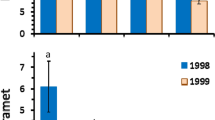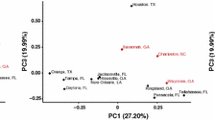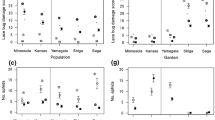Abstract
We studied the morphology, molecular genetics, and hebivory of two species of willows (Salix sericea and S. eriocephala) and their interspecific hybrids to test four alternative hypotheses concerning the effects of hybridization on plant resistance. Individually marked plants were identified using morphological traits in the field and measurements of stipule and leaf pubescence were made and compared using Canonical Discriminant Function Analysis. DNA was extracted from the leaves of a sample of the marked plants and RAPD-PCR analysis was performed to establish the genetic status of parental and hybrid plants. RAPD band analysis generally verified the genetic status of parental plants. Hybrid plants were usually correctly identified in the field with a few exceptions. However, the hybrid plants were a heterogeneous group of plants made up of most plants that appear to be F1s and a few plants that appear to be backcrosses to S. sericea. Morphological variables were useful for distinguishing S. sericea from S. eriocephala and hybrids, but were not as dependable in distinguishing between S. eriocephala and hybrids. We compared the densities of 11 herbivore species and the infection by a leaf rust pathogen (Melampsora sp.) on the leaves and stems of two parents and the hybrids in the field. We found support for the Additive hypothesis (3 species), the Dominance hypothesis (2 species) and the Hybrid Susceptibility hypothesis (7 species, 6 herbivores and the Melampsora rust). We found no evidence for the Hybrid Resistance hypothesis. Guild membership was not a good predictor of similar responses of species to hybrid versus parental plants. A Canonical Discriminant Function Analysis showed discrete separation of the taxa based on herbivore densities, illustrating different community structures on hybrid and parental plants. This study demonstrates the diversity of responses of phytophages in response to interspecific hybridization.
Similar content being viewed by others
References
Aguilar JM, Boecklen WJ (1992) Patterns of herbivory in the Quercus grisea x Quercus gambelii species complex. Oikos 64:498–504
Argus GW (1974) An experimental study of hybridization and pollination in Salix (willows). Can J Bot 52:1613–1619
Argus GW (1986) The genus Salix (Salicaceae) in the southeastern United States. Syst Bot Monogr 9:1–170
Barton NH, Hewitt GW (1985) Analysis of hybrid zones. Ann Rev Ecol Syst 16:113–148
Boecklen WJ, Spellenberg (1990) Structure of herbivore communities in two oak (Quercus spp.) hybrid zones. Oecologia 85:92–100
Brunsfeld SJ, Soltis DE, Soltis PS (1992) Evolutionary patterns and processes in Salix sect. Longifoliae: Evidence from chloroplast DNA. Syst Bot 17:239–256
Dorn RD (1976) A synopsis of american Salix. Can J Bot 54:2769–2789
Doyle JJ, Doyle JL (1987) A rapid DNA isolation procedure for small amounts of fresh leaf tissue. Phytochem Bull 19:11–15
Drake DW (1981) Reproductive success of two Eucalyptus hybrid populations. II. Comparison of predispersal seed parameters. Aust J Bot 29:37–48
Edwards MD, Stuber CW, Wendel JF (1987) Molecular markerfacilitated investigations of quantitative trait loci in maize. I. Numbers, genomic distribution and types of gene action. Genetics 116:113–125
Falconer DS (1989) Introduction to quantitative genetics. Third edition. Longman Scientific and Technical, Essex
Floate KD, Kearsley MJC, Whitham TG (1993) Elevated herbivory in plant hybrid zones: Chrysomela confluens, Populus and phenological sinks. Ecology 74:2056–2065
Fritz RS (1992) Community structure and species interactions of phytophagous insects on resistant and susceptible host plants. In Fritz RS, Simms EL (eds) Plant Resistance to Herbivores and Pathogens: Ecology, Evolution, and Genetics. The University of Chicago Press, Chicago, pp 240–277
Fritz RS, Price PW (1988) Genetic variation among plants and insect community structure: willows and sawflies. Ecology 69:845–856
Grant V (1981) Plant speciation. Second edition. Columbia University Press, New York
Hall RW, Townsend AM (1987) Suitability of Umus wilsoniana, the ‘Urban’ elm, and their hybrids for the elm leaf beetle, Xanthogaleruca luteola (Müller) (Coleoptera: Chrysomelidae). Environ Entomol 16:1042–1044
Hanhimäki S, Senn J, Haukioja E (1994) Performance of insect herbivores on hybridising trees: the case of the subarctic birches. J Anim Ecol (in press)
Hewitt GM (1988) Hybrid zones — natural laboratories for evolutionary studies. Trends in Ecology and Evolution 3:158–167
Huesing J, Jones D, Deveerna J, Myers J, Collins G, Severson R, Sisson V (1989) Biochemical investigations of antibiosis material in leaf exudate of wild Nicotiana species and interspecific hybrids. J Chem Ecol 15:1203–1217
Jokela JJ (1966) Incidence and heritability of Melampsora rust in Populus deltoides Bartr. In: Gerhold HD, Schreiner EJ, McDermott RE, Winieski JA (eds) Breeding Pest-Resistant Trees. Pergamon Press, Oxford, England, pp 111–117
Keim P, Paige KN, Whitham TG, Lark KG (1989) Genetic analysis of an interspecific swarm of Populus: Occurrence of unidirectional introgression. Genetics 123:557–565
Knobloch IW (1972) Intergeneric hybridization in flowering plants. Taxon 21:97–103
Levy A, Milo J (1991) Inheritance of morphological and chemical characters in interspecific hybrids between Papaver bracteatum and Papaver pseudo-orientale. Theor Appl Genet 81:537–540
Maddox GD, Root RB (1990) Structure of the encounter between goldenrod (Solidago altissima) and its diverse insect fauna. Ecology 71:2115–2124
Martin GB, Williams JGK, Tanksley SD (1991) Rapid identification of markers linked to a Pseudomonas resistance gene in tomato by using random primers and near-isogenic lines. Proc Natl Acad Sci USA 88:2336–2340
Meier B, Bettschart A, Shao Y, Lautenschlager E (1989) Einsatz der modernen HPLC für chemotaxonomische Untersuchungen morphologisch schwer zu differenzierender Salix-Hybriden. Planta Medica 55:213–214
Mosseler A (1990) Hybrid performance and species crossability relationships in willows (Salix). Can J Bot 68:2329–2338
Mosseler A, Papadopol CS (1989) Seasonal isolation as a reproductive barrier among sympatric Salix species. Can J Bot 67:2563–2570
Nason JD, Ellstrand NC, Arnold ML (1992) Patterns of hybridization and introgression in populations of oaks, manzanitas, and irises. Am J Bot 79:101–111
O'Donoughue LS, Raelson JV, Grant WF (1990) A morphological study of interspecific hybrids in the genus Lotus (Fabaceae). Can J Bot 68:803–812
Paige KN, Capman WC (1993) The effects of host-plant genotype, hybridization and environment on gall aphid attack and survival in cottonwood: The importance of genetic studies and the utility of RFLP's. Evolution 47:36–45
Paige KN, Keim P, Whitham TG, Lark KG (1990) The use of restriction fragment polymorphisms to study the ecology and evolutionary biology of aphid-plant interactions. In: Eikenbary RD, Campbell RK (eds) Mechanisms of aphid-plant genotype interactions. Elsevier, Amsterdam, pp 69–87
Paige KN, Capman WC, Jennetten P (1991) Mitochondrial inheritance patterns across a cottonwood hybrid zone: Cytonuclear disequilibria and hybrid zone dynamics. Evolution 45:1360–1369
Rabotyagov VD, Akimov YA (1987) Inheritance of essential oil content and composition in interspecific hybridization of lavender. Soviet Genetics 22:1163–1172
Rice WR (1989) Analyzing tables of statistical tests. Evolution 43:223–225
Rieseberg LH, Brunsfeld SJ (1992) Molecular evidence and plant introgression. In: Soltis PS, Soltis DE, Doyle JD (eds) Molecular Systematics of Plants, Chapman and Hall, New York, pp 151–176
Rieseberg LH, Wendel JF (1993) Introgression and its consequences in plants. Hybrid zones and the evolutionary process. In: R. Harrison (ed) Oxford Univ Press, New York, pp 70–109
Stebbins GL (1950) Variation and Evolution in Plants. Columbia Univ. Press. NY
Stebbins GL (1959) The role of hybridization in evolution. Proc Am Phil Soc 103:231–251
Verwijst T (1990) Clonal differences in the structure of a mixed stand of Salix viminalis in response to Melampsora and frost. Can J For Res 20:602–605
Welsh J, McClelland M (1990) Fingerprinting genomes using PCR with arbitrary primers. Nucl Acids Res 18:7213–7218
Whitham TG (1989) Plant hybrid zones as sinks for pests. Science 244:1490–1493
Whitham TG, Morrow PA, Potts BM (1991) Conservation of hybrid plants. Science 254:779–780
Whitham TG, Morrow PA, Potts BM (1994) Plant hybrid zones as centers of biodiversity: The herbivore community of two endemic Tasmanian eucalypts. Oecologia (in press)
Widin DK, Schipper AL Jr (1976) Epidemiology and impact of Melampsora medusae leaf rust on hybrid poplars. In: Intensive Plantation Culture: Five Years Research. USDA, Forest Service, General Technical Report, NC-21, pp 63–74
Williams JGK, Kubelik AR, Livak KJ, Rafalski JA, Tingey SV (1990) DNA polymorphisms amplified by arbitrary primers are useful as gentics markers. Nucl Acids Res 18:6531–6535
Author information
Authors and Affiliations
Rights and permissions
About this article
Cite this article
Fritz, R.S., Nichols-Orians, C.M. & Brunsfeld, S.J. Interspecific hybridization of plants and resistance to herbivores: hypotheses, genetics, and variable responses in a diverse herbivore community. Oecologia 97, 106–117 (1994). https://doi.org/10.1007/BF00317914
Issue Date:
DOI: https://doi.org/10.1007/BF00317914




